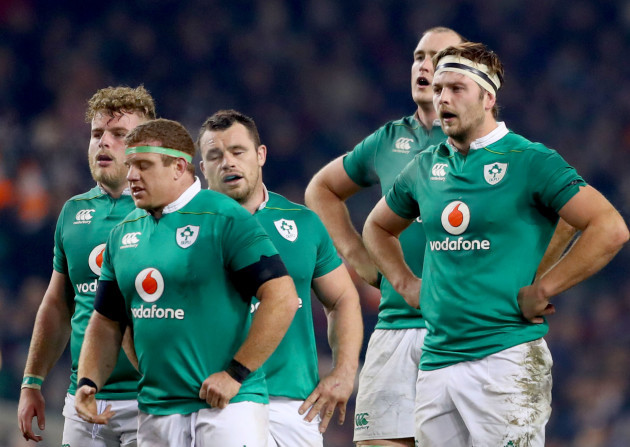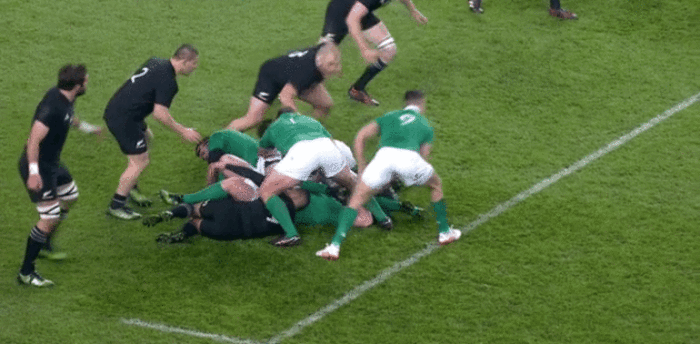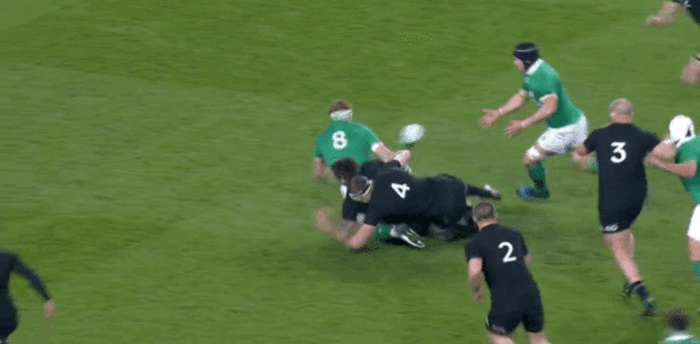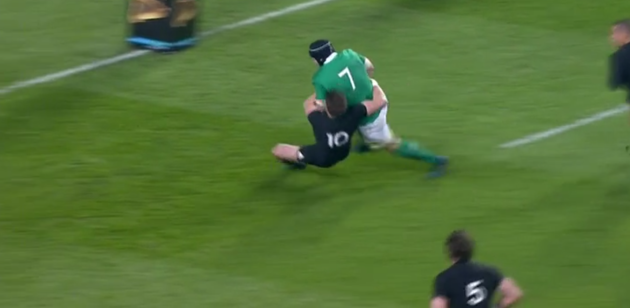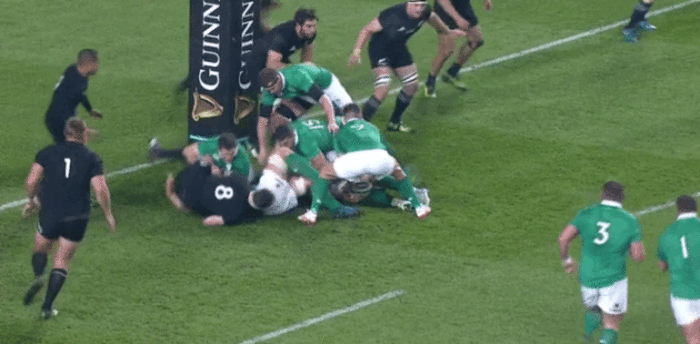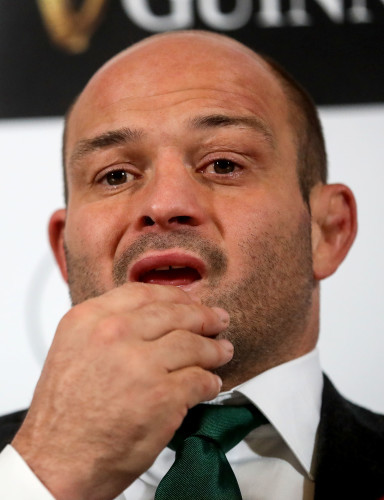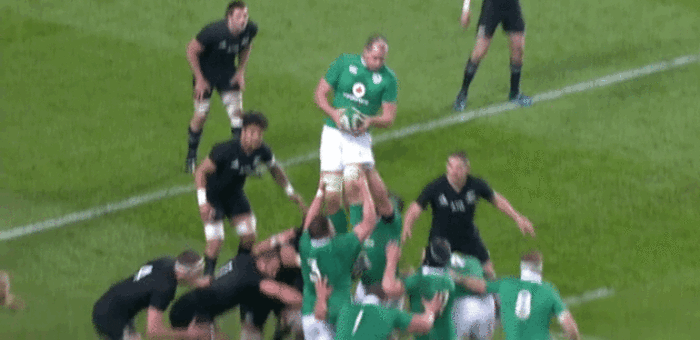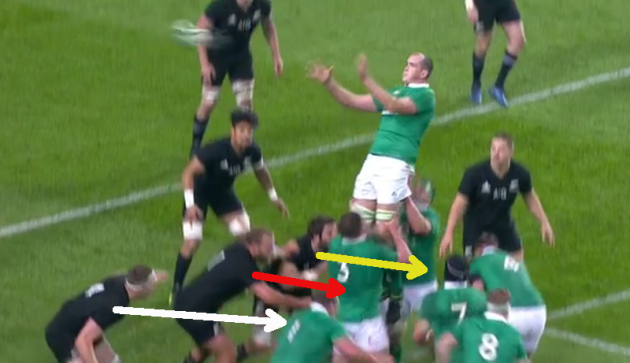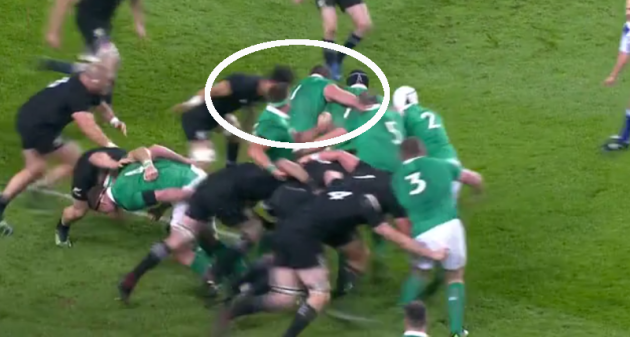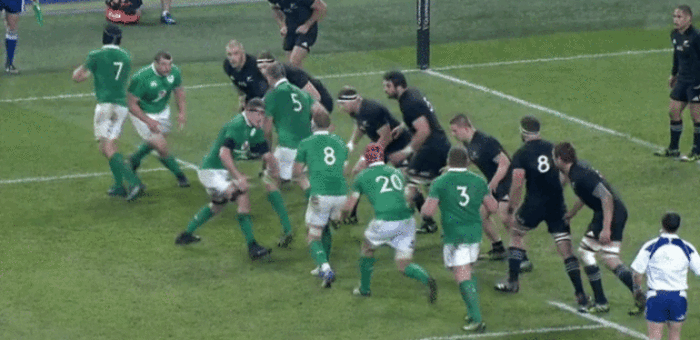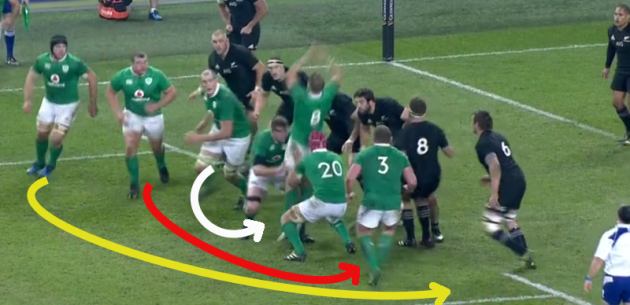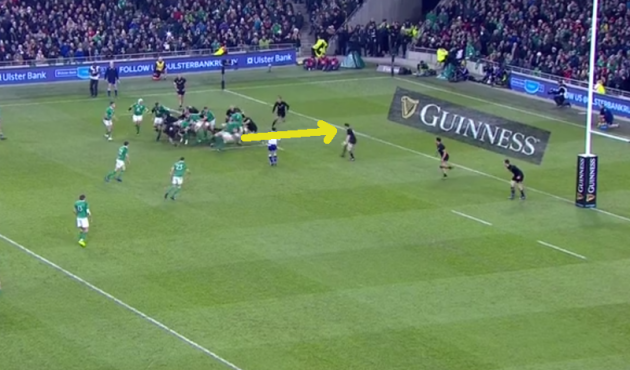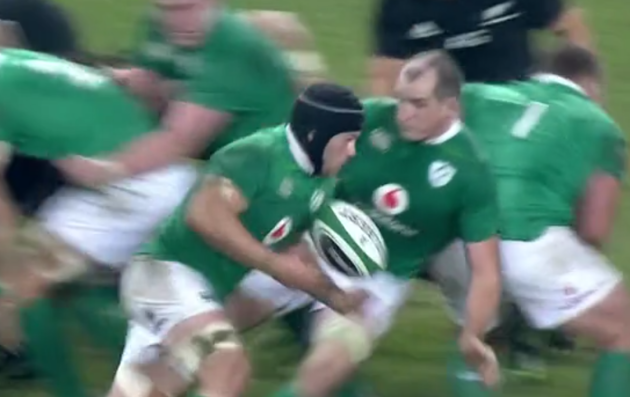WITH A TOTAL time of 23:47 in possession, as well as 65% of the territorial advantage, Ireland’s failure to score a try was extremely costly against New Zealand yesterday.
To put the scale of Ireland’s possession in context, they had 18:03 of possession in their win in Chicago, when they managed to score five tries.
Whatever about the much-discussed performance of the match officials, this profligacy was perhaps the central reason for Ireland’s defeat.
Over 60% of the possession and territory is always welcome, but Ireland struggled to convert the impressive numbers into the scores that would have made a difference against the All Blacks.
Joe Schmidt’s side came extremely close to securing a crucial five-pointer on a number of occasions, but just couldn’t get over the line – even when they did.
With New Zealand scoring three tries with their 14:45 of possession and 35% territory, Ireland’s failings in the green zone were the key difference in this game.
Encouraging beginnings
After conceding an early try to the Kiwis – echoing events in Chicago – Ireland bounced back strongly and almost responded with one of their own.
The very first Ireland lineout of the evening was picked off by Sam Whitelock – a sign of the boost New Zealand’s returning second row would give them – but Tadhg Furlong pounced on the loose ball as Aaron Smith failed to control it.
Jamie Heaslip always uses his felt well pre-contact, rarely allowing the first defender to get a firm shoulder onto him. That’s the case again here, as he steps in off his right foot to beat Joe Moody, then shows his power to go right through Kieran Read’s tackle attempt.
A brilliant contribution finishes with a clever offload to Sean O’Brien, who reacts to Heaslip’s half-break sharply by getting to his right shoulder and accepting the ball.
The ball arrives low around his thighs, meaning O’Brien has to spend a vital split second ensuring he actually gathers it in. Ireland’s openside surges for the line, but this incident is all about the pace and determination of Beauden Barrett.
The All Blacks out-half gets to O’Brien within three rapid strides and intelligently grabs him by the shoulders, swinging himself around and underneath the ball, ensuring that the momentum will bring O’Brien to deck with Barrett under the ball.
As important as the tackle itself is Barrett clinging on after it has been completed. He has no intention of releasing his vice grip around the ball, possibly allowing O’Brien to either stretch out an arm or be driven over the tryline by a team-mate to score.
Illegal, but any player in his position would have attempted to do the same and Barrett ultimately prevents an Ireland try.
From the subsequent scrum, another strong Heaslip carry brings Ireland back to within striking range, only for Stander to be held up this time.
Again, a slight illegality from the All Blacks helps them prevent the score. Sam Cane and Anton Lienert-Brown both jump offside to the right of Ireland’s ruck as they come forward to tackle Stander.
It’s a matter of inches as they retreat from their first jump of the gun, but those inches contribute to both players getting in underneath the powerful Stander as he drives over the line.
Johnny Sexton’s penalty provides three points for Ireland, though that could so easily have been seven.
Close calls for Ireland in the opening eight minutes, but they wouldn’t breach the tryline again all game.
A decision to take points
Why didn’t Ireland go after a try with the penalty they won under the posts with Aaron Smith still in the sin bin?
The question has been asked a number of times since yesterday’s encounter, and this was Ireland captain Rory Best’s take on the matter:
“It was just about getting on the board, getting points. Obviously, the scrum was a real tussle and I think in some scrums they were getting the squeeze on us and some scrums we were getting the squeeze on them.
“It was quite a distance out to go for the corner, so we just wanted to get points on the board. They were a man down and we felt we could try to build back into the game, give ourselves a foothold and then if we got the next score, we go ahead. That was the thinking.”
It’s easy to critique these decisions with the benefit of hindsight or from a cosy seat in the stand, but it did seem at odds with the try-scoring attitude Ireland had brought in Chicago.
There was risk attached to opting for a set-piece, particularly with the front row apparently not feeling they had complete control, but that same dash of risk made an important difference at Soldier Field when Ireland made history.
Five-metre failings
Ireland had a number of chances to convert short-range lineouts into tries against the All Blacks yesterday, but failed to take any of the opportunities.
The 18th minute provided exactly the same chance Ireland took for Jordi Murphy’s try early on in Chicago, a five-metre lineout in the left corner.
Having gone 14-3 down after Barrett’s try, Ireland declined a shot at the posts with the penalty that saw Aaron Smith sin binned, instead backing their maul to get the job done.
What Ireland attempt to do here is essentially exactly the reverse of the move that led to Murphy’s try in Chicago.
Donnacha Ryan [red below] is intended to be the spearhead of the shift drive off to the right of the transfer, with Jamie Heaslip [yellow] joining on Ryan’s right side.
O’Brien is the receiver, accepting the transfer from lineout catcher Devin Toner [blue], while Jack McGrath’s role [white] is to bind on the inside of O’Brien, therefore providing protection as the drive hopefully shifts off to the right.
All of this mirrors the mauling set-up for the Murphy try in Chicago, but there’s a crucial difference at play in this Dublin fixture.
With Brodie Retallick and Whitelock back in the All Blacks team, they have two of their best maul defenders ready to fire. And while the Kiwis are down to 14 men, that missing player is not their loosehead prop this time.
Whitelock [yellow] counter drives from the middle of the lineout, while Joe Moody [red] is on his inside. As important is the work of Retallick [white], one man closer to the touchline.
The combined technique of these three men, the power of their counter-drive, means that the Kiwis manage to splinter Ryan and Heaslip from O’Brien and McGrath before Ireland hooker Rory Best can even arrive to accept a second transfer from O’Brien.
Ireland’s cohesion is just off, and O’Brien is forced to break away to the right. Unfortunately for Schmidt’s side, McGrath doesn’t unbind from O’Brien and therefore blocks Ardie Savea from tackling the ball carrier.
Referee Jaco Peyper correctly signals a penalty to New Zealand and it’s a huge win for their maul defence.
The second big failing from a five-metre Ireland lineout came in the 49th minute, and with the Kiwis again down to 14 men after Malakai Fekitoa’s yellow card. Trailing 14-6 at the time, this could have been a game changer.
This failure to convert was even more frustrating for Ireland as they put the ball down on a gilt-edged try-scoring opportunity.
It’s a clever trick play that Ireland have used before, with O’Brien, Toner and McGrath coming from the front of the lineout to create an opening for ball carrier O’Brien at the tail.
Toner swivels around to accept the first transfer from lineout catcher Heaslip, while McGrath gets all the way around to the right of Furlong, and O’Brien is the last to arrive in order to accept a second transfer from Toner.
McGrath’s role is key here, as he serves to lure in the New Zealand tailgunner, Ardie Savea, at the very back of the lineout.
The rather blurry image below just about highlights that happening in the top right corner.
That in turn means that O’Brien is running directly into a gap on out-half Barrett’s inside shoulder.
Aaron Smith is covering across from his starting position in behind the lineout, but the space is clear.
A clean transfer to O’Brien and this is an almost certain Ireland try.
Toner and O’Brien are likely to both hold their hands up for the failure of their transfer. The second row might feel he could have planted the ball more firmly into O’Brien’s body, while the flanker will rue getting his eyes up before he gathered the ball.
Ireland aren’t the kind of side who tend to create scores on turnover possession and kick return – as New Zealand do so regularly.
Schmidt’s men score the majority of their tries from lineout platforms like the two above, with the maul and trick plays based on their mauling threat having been crucial parts of their previous successes.
Ireland generally don’t create the kind of scores New Zealand tend to conjure in the blink of an eye – Fekitoa’s second for instance – and, therefore, the kind of scoring opportunities in the two examples above are even more important.
Failure to convert these two chances, and handful of others within close proximity to the New Zealand tryline, was incredibly costly.
We will discuss other aspects of Ireland’s attack elsewhere in the next day or so, including their relentless directness inside the opposition 22 and their decision-making on the ball, but these examples very much underline the theme of the game.
New Zealand were better defensively than in Chicago, their returning second row provided an important boost in areas that dented Ireland’s effectiveness, and Schmidt’s men lacked the required accuracy to turn large amounts of possession and territory into the tries that were always going to be required.
The42 is on Instagram! Tap the button below on your phone to follow us!
